Most of us know the chid-like joy of seeing a colorful butterfly flitting past us. It’s a small look into what feels like a completely different world – one with magic in it.
But it may be difficult to imagine thousands and thousands of these magnificent creatures filling the skies, almost blotting out the sun when they fly.
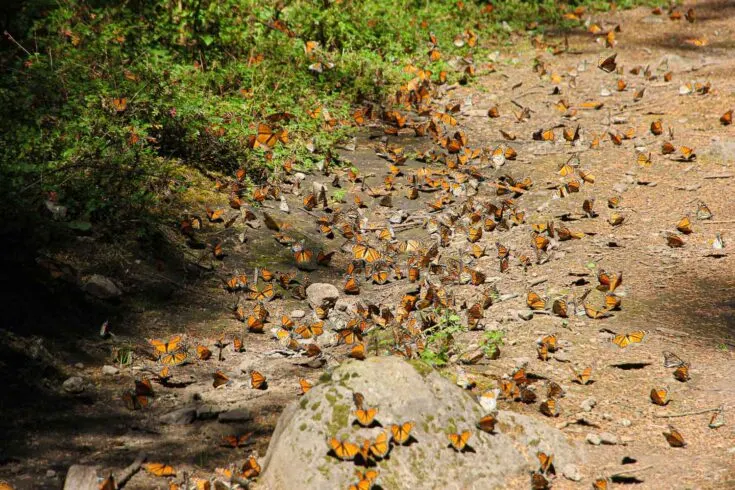
This fantastic phenomenon is rare but can be seen and experienced in central Mexico.
Outside the charming town of Morelia is an incredible UNESCO World Heritage Site that these butterflies call home.
The Monarch Butterfly Biosphere Reserve is the only place in the world where this phenomenon can be seen, and butterflies travel far and wide to reach it.
In fact, Monarch butterflies from all over North America and as far as Canada migrate here every year. That’s up to 4034 km (2500 miles) of traveling.
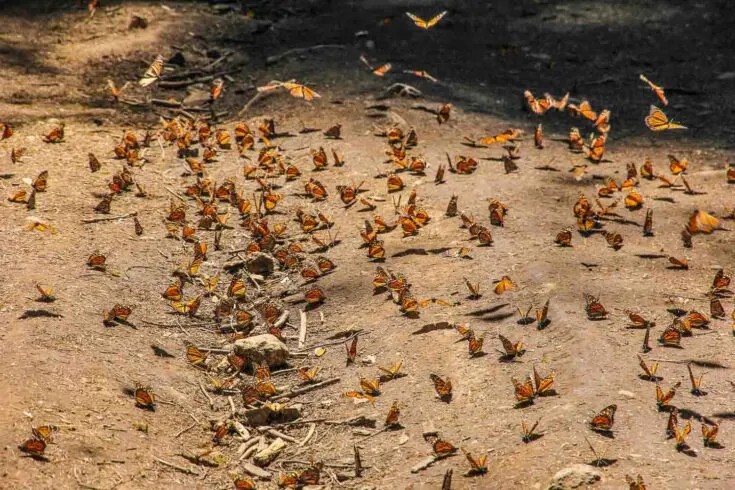
If they can travel that far, it’s certainly worth you traveling to meet them.
This is definitely one of the most awe-inspiring things you are likely to experience in one of the top places to visit in Mexico.
Monarch Butterfly Migration to Mexico
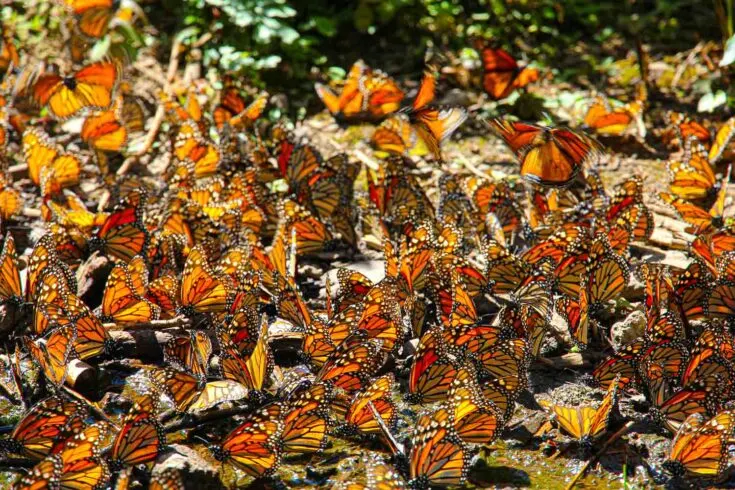
Monarch butterflies have the most complicated, evolved migration pattern of all known butterfly and moth species.
It is expected that theirs may actually be the most complex out of all insects.
Every winter, from November to March, countless Monarch butterflies arrive in the Monarch Butterfly Biosphere Reserve.
The long migration takes them about eight months in total, from when they leave the reserve to when they return.
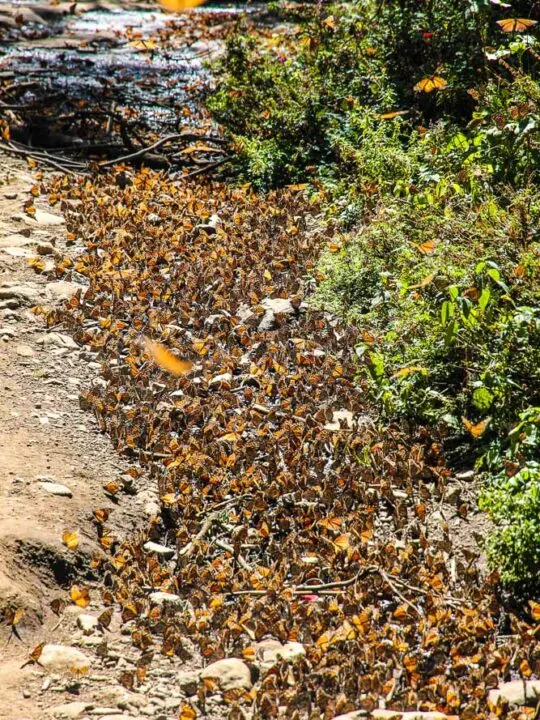
Since butterflies have a particularly short lifespan, four generations will be born and die before they arrive at their destination.
Each butterfly will live for only four to five weeks. How they know to travel to one specific space, through generations, is a mystery to us.
In the spring, they start their migration all over again, going as far as East Canada.
Their journey varies between 1,900 and 4,000 km (1,200 and 2,500 miles) every year, depending on where they will return to.
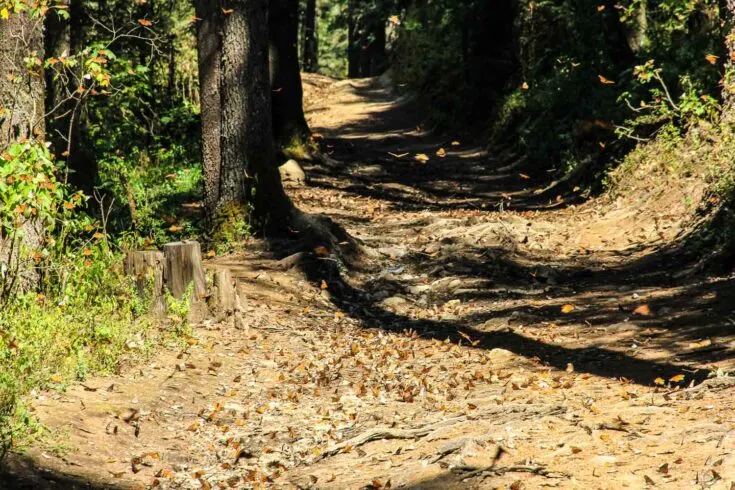
Why Do They Migrate to Mexico?
These butterflies arrive in Mexico during the winter months because it is far warmer than their other habitats. Mexico is known as their ‘overwintering’ habitat.
The Monarch migration is very different from the migration patterns of mammals and other animals.
This is because other creatures may migrate several times during their lifespans and arrive somewhere where they will either hibernate, mate, or birth.
Monarch butterflies will go through their entire lives either traveling here or could go through their whole lifespan at the reserve.
So they are not migrating for a specific life stage but rather to survive the colder months.
What are Michoacan Monarch Butterflies?
The Monarch butterfly is one of the most common and familiar butterflies in North America. Depending on the region, they are also known as milkweed, common tiger, black veined brown, and wanderer.
Along with bees, they are very important pollinators and are known as an iconic pollinator species.
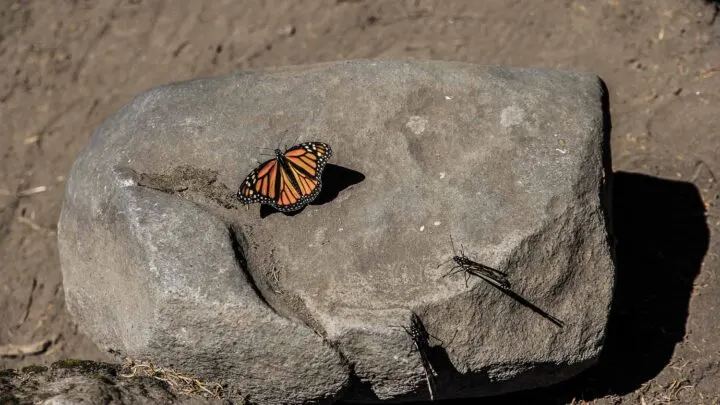
Their brilliant characteristic coloring makes them easily recognizable, and you’ve most likely seen a few flitting about your garden before.
They have predominantly orange-red wings with black veins and white spots along those dark lines. Their bodies are also black with bright white spots.
The strong contrasting colors make them stand out wonderfully.
They are sometimes known as Michoacán Monarch Butterflies because Michoacán is the Mexican state where they alight. Morelia is the capital city of this state.
How Many Monarchs in Mexico?
It’s impossible to even consider counting the number of Monarch Butterflies in Mexico, they are just too plentiful.
But to give you an idea, we can assume a Monarch Butterfly weighs, on average, about half a gram.
This can vary from about 0.27 grams (for a very small monarch) to about 0.75 grams.
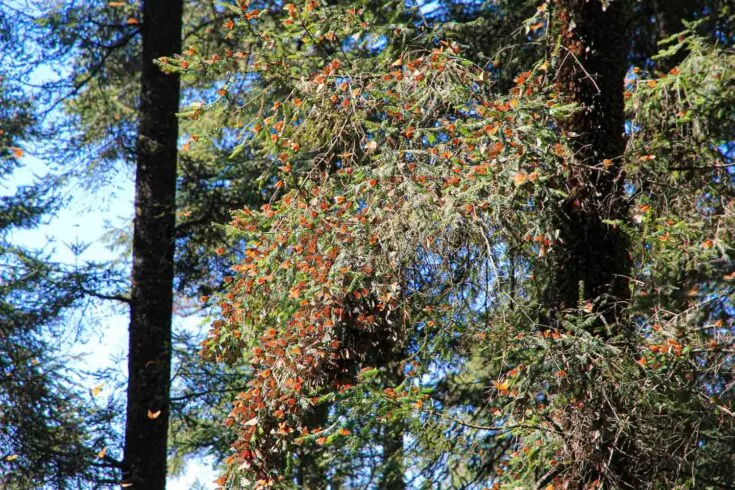
So many butterflies cluster together on the branches of the pine and oyamel trees in the reserve that tree branches often bend or even break from their weight.
So you can just imagine how many of them are swarming the trees during peak season in late December.
There are so many butterflies here that when walking amongst them, you’ll struggle to keep them out of your mouth and eyes.
I visited in mid-November before peak season had even started, and I found the experience of so many butterflies just a little bit overwhelming, though incredible.
Threats to the Butterfly Migration in Mexico
While the trees are still thick with butterflies, there has been a significant decrease in the Monarch Butterfly population in recent years.
The numbers taking part in this great butterfly migration are dwindling.
Though, as previously mentioned, it’s impossible to count or quantify the butterfly population correctly, it’s clear that their numbers have dropped from the amount of forest they occupy.
Some blame climate change, while other major culprits include heavy logging, mining, and farming. All of which are problematic in the surrounding areas.
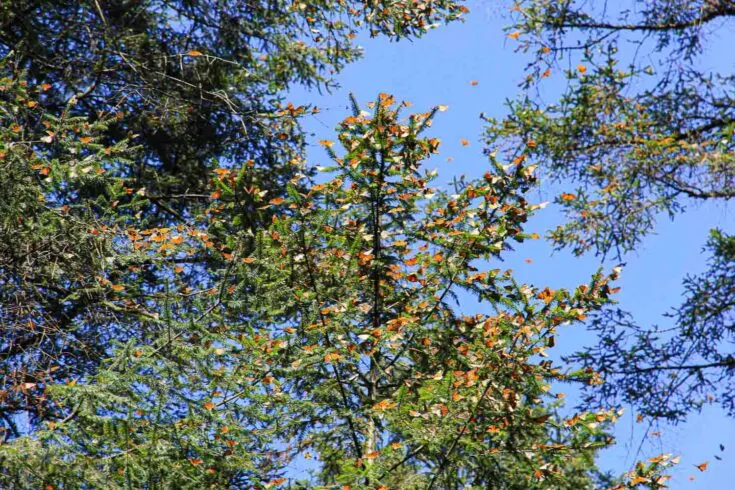
Climate change disrupts their annual migration pattern by affecting weather conditions in both their wintering grounds and summer breeding grounds.
From cold winters possibly causing their early deaths and hotter, drier summers affecting their habitats, climate change can be catastrophic for this little species.
In addition to this, drought and the common use of pesticides and herbicides on their main food source, the milkweed plant, means less food for caterpillars.
Milkweed is also the only plant that they can lay their eggs in, so the reduction of this plant is very problematic for this species.
All of this means that there are fewer butterflies to migrate south for the winter.
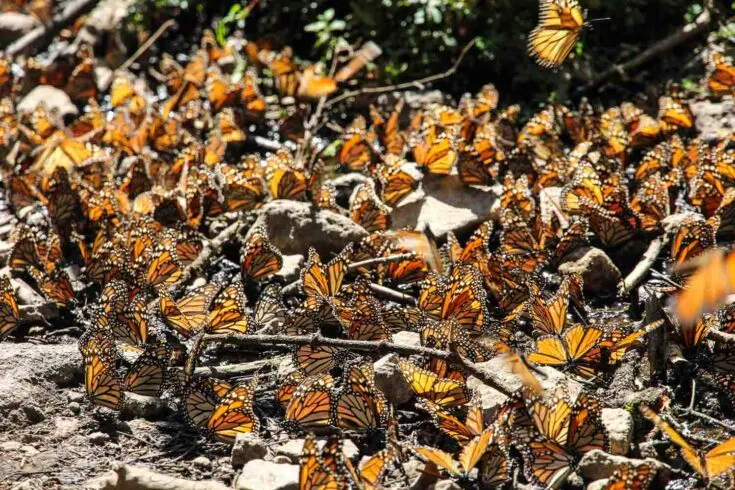
In the last two decades, the population has dwindled rather drastically. From 45 acres of habitat in 1995, to 5 acres in 2020 (a 26% decrease from the previous year).
Things are not looking too good for these flitting creatures. In addition to their population losses, the quality of their habitat is being degraded.
That being said, the reserve, World Wide Fund for Nature (WWF), UNESCO, and local communities and partners are all working together to ensure that these magical insects are around for a long time to come.
How to Get to Monarch Butterfly Biosphere Reserve
The reserve is located three hours west of Mexico City, three hours south of San Miguel De Allende, and an hour and a half from Morelia.
Witnessing this great migration means experiencing one of nature’s grandest miracles.
So it is certainly worth the drive, especially when it’ll take you through the fascinating landscapes of Mexico.
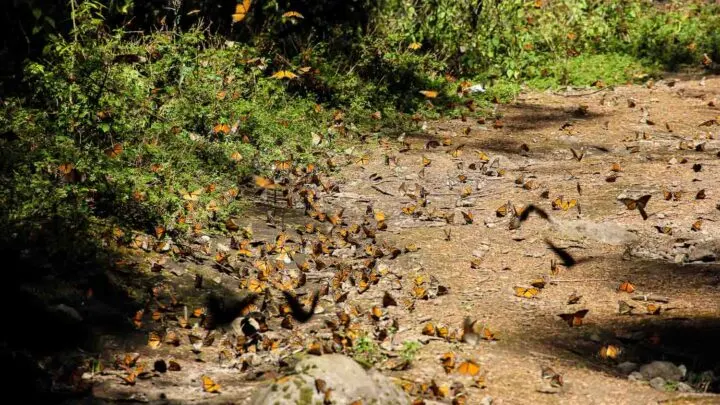
There are two main ways to get to the butterfly reserve, and that is by car or by bus.
If you are renting a car in Mexico, it’s simple enough to drive to the reserve, with the best town to stay in being Angangueo.
If you’re taking the bus from Mexico City, head to Terminal Centro Poniente and take the pink Line 1 bus directly to Angangueo. From here, you can find public or private transportation to the reserve.
You need a guide to access and explore the reserve. It is not possible to venture out by yourself, so it may be worth booking an all-inclusive tour that ensures you make the most out of the experience.
Alternatively, there are a number of local travel companies in the major cities that you could book with the prices often being only 550MXN/30USD.
This way, you will also be transported to the reserve, without fuss or worry.
A day trip typically starts at around 8 am, and you will return at 7:30 pm. The drive takes about four hours one way.
At the reserve, there is a small museum where you can learn a little more about these bright insects before you experience them.
There are also a few restaurants here as well as a shop, where it’s recommended you grab a bottle of water before moving on.
From the reserve parking lot, you’ll take a 30-minute hike up the mountain.
There are horses available for those that can’t make the climb, but you’re still encouraged to wear proper walking shoes.
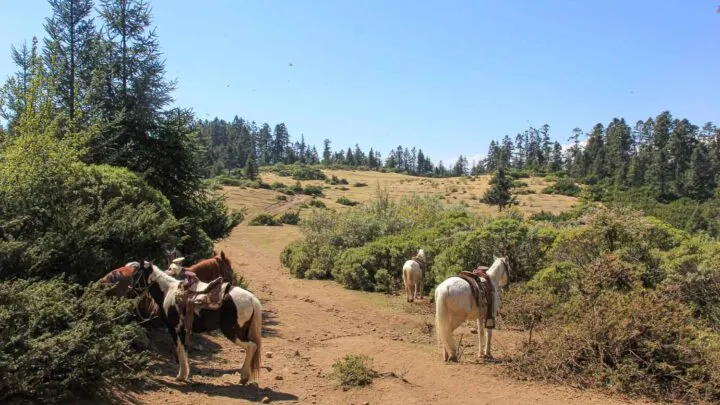
At the beginning of the climb, you might wonder if you’re in the right place because you won’t see any butterflies at all.
As a matter of fact, you won’t see any butterflies until you are done with the climbing. And then, suddenly, there are thousands of them all around you.
It’s an incredible experience and one that you’re not likely to ever forget.
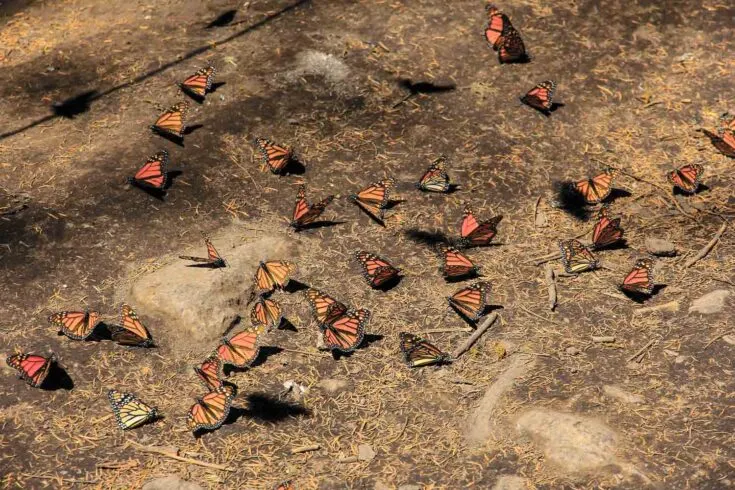
Ready to See the Monarch Butterfly of Mexico?
Not only are these brightly colored insects beautiful, but they’re also impressive.
Traveling halfway across the U.S. continent, these butterflies are an excellent example of the determination and capability of the natural world.
See thousands of butterflies covering every inch of tall forest trees, flitting past your face, and filling the skies as they fly.
It’s an unforgettable experience that is sure to affect your understanding of the word ‘awesome’.
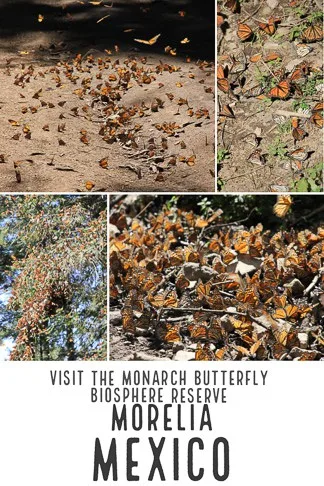

ZihuaGuy33
Monday 1st of April 2019
good article, nice photos! but since when is Morelia a small town?
Christian L.
Monday 1st of April 2019
My mistake, Morelia is the 27th largest city in Mexico